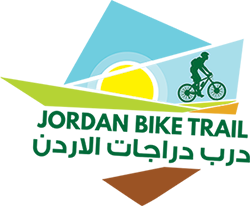
Packing for the Jordan Bike Trail is not dramatically different than packing for any other bikepacking trip. Carry only what you need to be safe and comfortable for the duration of your trip. Because there are few bike shops in Jordan, carry everything you need to fix mechanical failures on the trail. Go as light as you can, while still saying safe—the Jordan Bike Trail has loads of long climbs!
Jordan’s climate is relatively mild and will only reach freezing in winter in high elevations, so you won’t have to carry heavy winter gear. Still, if you’re riding in winter or spring, temperatures can be cool and there may be rain, so be prepared with insulating layers and lightweight rain gear.
Bike Setup
You can ride with pannier racks and bags, but we recommend a traditional bikepacking setup, with seatpost bag, frame bag, handlebar bag, and various other top tube bags and gear cages (you may be able to ride with less!). If you’re new to bikepacking, Bikepacking.com has plenty of useful information. Parts of route are rougher than is comfortable for riding with pannier bags. What’s more, riding with bikepacking bags will force you to pack lighter (less space) than with a pannier setup.
Since some sections are a bit rough/rocky, we recommend riding a mountain bike. A rigid steel mountain bike without suspension is sufficient, but you may be happy for front suspension on some descents. Since 60% of the route is on pavement, there’s no need for an excessively knobby tire; however, some parts of the route travel through loose, sandy terrain. There, you’ll be happy for a tire well over 2” wide. (You’ll likely be walking otherwise.)
Sample Packing List
When packing, keep in mind the basic 10 essentials for any wilderness trip. Here’s a sample packing list organized by those categories:
- Navigation
– GPS unit with tracks
– Mobile phone with navigation app and tracks
– External battery
– USB charging cables
– Spare batteries
– Plug adapter - Sun Protection
– Sunscreen
– Sunglasses
– Long sleeve “sun hoodie” - Insulation
– Base layer
– Lightweight fleece layer - Illumination
– Head lamp
– Headlight
– Rear light
– Spare batteries - First Aid
– Small first aid kit - Fire
– Butane lighter and/or waterproof matches - Spare parts and tools
– Tire irons
– Multi-tool/allen wrench set
– Spoke wrench
– Spare spokes (x4)
– Spare tire
– Spare tubes (if not running tubeless)
– Patch kit
– Chain lube/grease rag
– Spare brake cable (we advise mechanical disc brakes instead of hydraulic brakes for touring)
– Spare shifter cable
– Spare brake pads
– Zip ties
– Chain breaker tool
– Electrical tape
– Pocket knife - Nutrition
– Enough food for the day’s ride, plus a spare meal - Hydration
– Enough water to reach next resupply + spare 1.5L
– 1.5L Naglene (x2) (mounted to front fork)
– 3L Platypus water bladder
– Sawyer water filter and Aqua Mira drops - Emergency Shelter
– Lightweight tarp/ground cloth (also serves as emergency shade)
Remember basic items not covered above, such as: bike clothing (no need for more than what you wear and a change of clothes), toiletries, passport, wallet, lightweight bike lock, etc.
